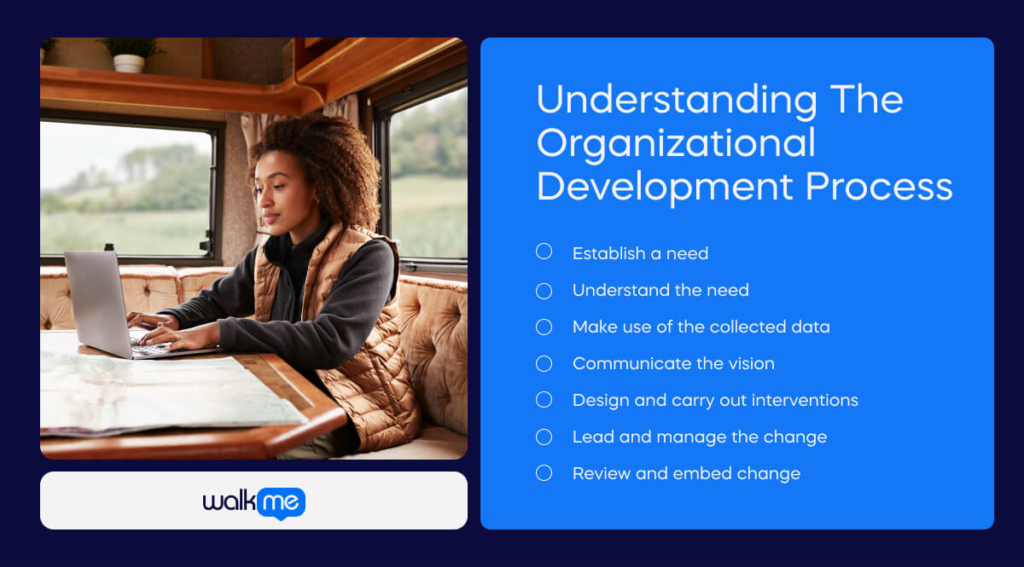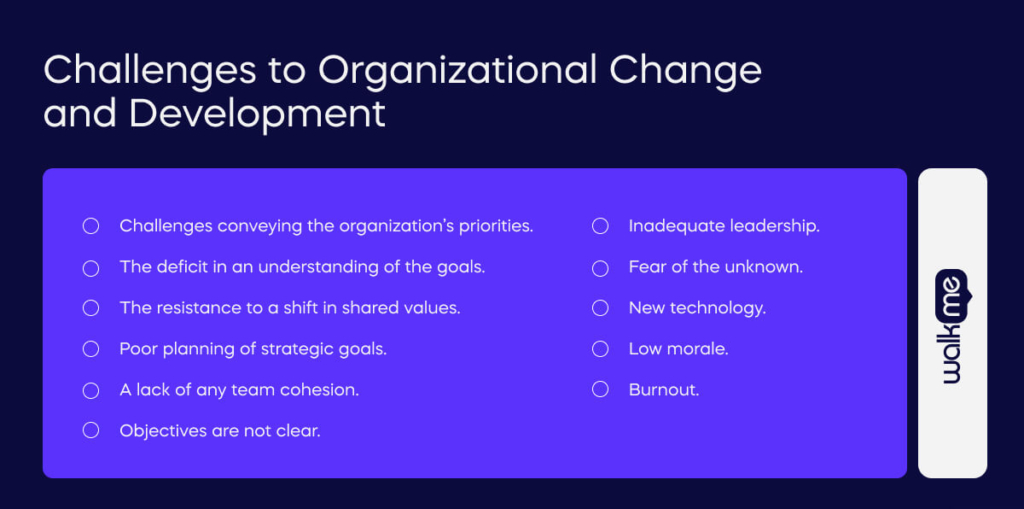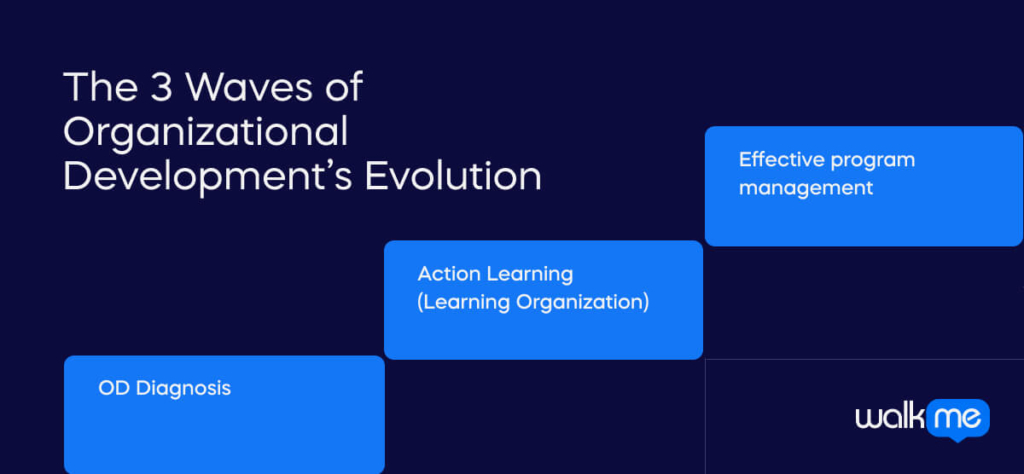Adaptability and change in individuals are valued more highly by organizations every year. The changes asked of team members can be small, such as moving to new workflow software or keeping digital records of their project progress. But what about more significant, company-wide changes?
How do staff contribute to their organization, ensuring it changes for the benefit of the individuals who make it and the company? What models can we use to guide the organizational development processes for change? And what do we need to know about the evolution of organizational development before we begin planning the change management strategy?
We can resolve these queries by picking apart organizational development (OD) components. Let’s jump straight in with defining what we mean by organizational development.
Organizational Development Defined
If you’re familiar with terms like change management, you will already know the basics of organizational development. The core of the organizational development process is increased efficiency through change. The desired outcome of this is optimal organizational effectiveness.
But organizational development refers explicitly to the changes occurring at the corporate level to enhance organizational performance driven by shareholders. Although we can include individual and group interventions within this, they are all achieved from the organizational perspective.
The definition of organizational development comes in three sections:
- Uses a critical/ science-based process – Scientific and intensive market research is the basis for organizational development processes.
- Embeds the skills to change within the staff to make the organization more effective – The staff’s readiness for and engagement with change defines the success of organizational development. Human resources departments are essential in supporting this aspect of OD.
- Creates, refines, and builds on structures, processes, and strategies – Reaching organizational development goals increases efficiency and company sustainability within the market
These processes must be followed methodically for the organizational development process to be successful, with a maximum yield of efficiency and employee productivity for growth and profits.
Organizational development processes need to shift to ensure companies meet goals. This process sounds simple enough, right? The approach is misleading in how straightforward it appears, as employees often resist change. This reason is why organizational development theory and practice are constantly changing.
The Objectives of Organizational Development

According to Gartner, “75% of companies expect to multiply the types of major change initiatives they will undertake in the next three years. Yet half of the change initiatives fail, and only 34% are a clear success.”
Many obstacles exist because staff often desire to stick to what they know regarding organizational development due to the variables of digital adoption. Some goals vary slightly based on company type and the reasons for implementing different organizational development strategies.
But OD leaders can use five common goals to steer any organizational development process in the right direction and support staff to get the most out of the process:-
- Increased profit
- Continuous improvement
- Better communication skills
- Individual employee development
- Products and services enhancements
The key to this process is excellent communication. Regular news updates on intranet sites and team meetings can inform staff of the rationale, progress, and success of organizational development strategies, improving employee engagement and company outcomes.
When staff understands why changes need to occur during the planning stage, even if they disagree, they feel respected and included when their company implements the strategy. This process also improves employee experience.
Understanding The Organizational Development Process

The organizational development process is easy to get to grips with on paper when we divide it into seven simple steps. However, the gap between theory and practice is always present. Implementing the process can be challenging when human factors, such as resistance to change and organizational culture come into play. Examining the OD process is a great way to start setting expectations and standards despite these obstacles.
- Establish a need
- Firstly, the team must establish a need that will require an organizational development strategy as a solution.
- If the team or OD leader cannot identify a need, employee surveys can help pick out issues, and the change leader can establish a need using this feedback.
- Understand the need
- Pull the need apart to understand why the problem exists.
- When you understand why the need exists and is unmet, it should become clear how to meet this need.
- If you are struggling with this step, enlist the support of OD specialist consultants.
- Make use of the collected data.
- Create a plan of action using the data you have collected.
- The plan should clearly define goals.
- The plan should allocate resources appropriately.
- Communicate the vision
- Senior staff communicates the plan of action as a future vision for the company.
- The correct leadership style must be chosen for this step, focusing on inspirational speakers.
- Design and carry out interventions
- Once the plan is in motion, carry out any training needed to implement it.
- Staff must be ready to engage positively with the OD practices to fulfill the need.
- Lead and manage the change
- How did the plan impact the need?
- Is the need affected, fulfilled, worsened, or improved?
- This stage is essential to learning from the OD process for the future.
- Review and embed change
- This stage is for feedback, where senior staff asks team members for their views on the OD strategy, what worked and what processes could be improved.
- Asking for feedback is essential at every stage of the OD strategy, particularly at the end, to reinforce the message that this is a shared and ongoing process.
Suppose the senior team needs support carrying out an OD strategy. In that case, the CEO can bring OD external strategy consultants to help implement OD interventions and new organizational structures. To follow these processes accurately, senior staff must gain familiarity and experience and possess excellent project management skills.
The Organization Development Process Cheat Sheet
OD can be a complicated process to get right, but it can yield powerful results. The method may still be challenging with our OD cheat sheet, but the change leader can reduce the time frame when using it. We have included all the terms you need in our cheat sheet for quick reference.
Business management involves four main areas: Organizational development, stakeholder value management, profit management, and operations management. These all relate closely to one another.
Organizational Development
The four primary areas of business management appear in a ring shape. Each section has its departments for which it is responsible. These are just listed here for quick reference.
1. Organizational development management:
- Talent Development
- Change Management
- Organizational Design
- Innovation
- Structured Idea Management
- Creativity
- Organizational Learning
2. Stakeholder value management
- Human Resources (HR)
- Marketing
- Sales
- Customer Care
- Public Relations (PR)
- Investor Relations
- Regulatory Affairs
3. Profit Management
- Accounting
- Taxation
- Finance
4. Operations Management
- Logistics
- Products and services production
- Resource management
Organizational development (in detail)
Stakeholder Value Management influences how change leaders can create value for internal and external stakeholders at every step. This action affects profit management, operations management, and organizational development management. OD impacts stakeholder value management, profit management, and operations management in minor or substantial improvements to react positively to ongoing market changes.
Profit management impacts organizational development, operations, and stakeholder value management. This action involves ongoing improvement to reduce costs and increase revenue to allow more significant profits, all directed by qualitative and quantitative metrics and analysis.
Operations management influences how a company uses organizational resources to create and transport products and services to external and internal stakeholders.
1. Organizational Development Management
This process starts with organizational learning, using research and analysis of all internal and external factors needed for company agility to promote growth.
A company can achieve organizational learning at individual, group, corporate and inter-organizational levels. The process utilizes skills, knowledge, ideas, and experiences from these different levels to scatter new ideas to adjust to internal and external changes that allow growth.
2. Stakeholder Value Management
All organizations have finite resources. So, any creative ideas produced by the creativity management process of organizational learning are measured using structured idea management to provide funds. This process means that statements provide the highest value for internal and external shareholders, leading to small and large innovations. Such innovations are created, improved, reviewed, and embedded within the business and technology models and the organization’s design. This process begins organizational changes internally and externally when achieved through change management principles. These more minor and more significant organizational changes and their products and services need internal stakeholders within the organization to be confident and adequately trained. These internal stakeholders can then communicate the changes to external stakeholders.
Human resources, customer service, public relations, sales, marketing, investor relations, and regulatory affairs departments establish and express the organization’s optimal logical features and emotional benefits to internal and external stakeholders. The departments achieve this while reducing structural weaknesses and potential threats, creating additional shareholder value.
Stakeholder value management employs the organizational development techniques of learning, creativity, structured idea management, and innovation while minimizing any weaknesses and threats to engineer value for stakeholders before, during, and after every step.
3. Profit Management
Shareholders then invest, and all the financial data, such as revenues, liabilities, equity, assets, profits, and expenses, are passed on to stakeholders and the financial team. The financial team then supports the company in model and deciding the value of future financial information in different situations, factoring in the costs and advantages. As a result of successful shareholder value management, shareholders gain confidence in the company as it is considered valuable instead of risky for investment.
4. Operations Management
The organizational activities and internal and external stakeholders supporting the organization to become more agile in better, faster, and lower-cost ways are kept on and funded. This action is based on financial cost-benefit analysis, using the organizational development techniques of creativity, learning, innovation, and structured idea management.
Conversely, ideas and people that do not support faster, better and lower-cost company agility are reviewed, realigned, funded, or released from the company and defunded.
Organizational actions and people that support organizational agility using faster, better, and lower-cost methods in the future are enhanced or acquired with funds previously spent on the people now released from the company and defunded. The company returns to deliver improved products and services for external and internal shareholders using the organizational development techniques of innovation, creativity, learning, and structured idea management. The corporate development process then begins once more.
Examples of Organizational Development Interventions
Due to organizational development’s complex and challenging nature, Cummings and Worley (2009) devised organizational development interventions to guide business processes in achieving organizational development successfully. These are divided into seven categories, each with several sub-categories, to ensure every base is comprehensively covered.
Human Process Interventions
Human process interventions are used in change strategies focusing less on performance management, interpersonal relations, and how the individual staff member fits into a group dynamic. This category includes several smaller categories that focus on specific areas of this complex topic, such as individual interventions.
Individual Interventions
Individual interventions focus on a specific individual and their ability to communicate with other members of their team or other departments. These interventions involve coaching to phase out unhelpful interpersonal behaviors, replacing them with productive ones.
Group Interventions
Group interventions alter group structure, content, and processes. The content is the focus of the group. The system is how a group is formed by reacting to the content. The process is the way the group performs its generic duties. Let’s look at an example. A contact center deals with customer complaints. The contact center has a top-down structure, including a director, managers, and a customer service team. A small percentage of these complaints are dealt with by management, judged on their severity or complexity. The process of the contact center is recording all complaints in as little time as possible.
Intergroup Relations Interventions
Intergroup relations interventions aim to diagnose and understand in-group relations. Companies use these interventions to establish issues, set goals, and work on specific problems.
Technostructural Interventions
Technostructural interventions are change programs focused on the structure and technology that form the organization’s core. Today, these interventions are at the forefront of organizational development processes due to the prominence of technology’s ability to disrupt, creating the need for agility and change in the organization development process.
Organizational (Structural) Design
Organizational structure significantly influences how it functions and how organization development can take place. The generic hierarchy structure in business is an example of a functional structure, whereby the system is composed of and built upon the significance of the company’s specific tasks.
Other structures exist, such as divisional, matrix, process, customer-centric, and network.
Key activities of organizational design include reengineering and downsizing. These activities rethink how staff accomplishes work, helping to prepare the company for change and leading to essential restructuring focused on the new business processes.
Total Quality Management
Total quality management came from the manufacturing industry’s emphasis on quality control, and OD teams can also refer to them as continuous improvement, lean, and six-sigma.
Customer satisfaction is central to long-term organizational success. This intervention is carried out with a strong emphasis on employee engagement in the continuous product improvement and continuously improving processes and workplace culture. Car manufacturers such as Toyota and smartphone manufacturer Motorola utilize this intervention.
Work Design
Work design is about designing a workload to optimize productivity. Employees complete tasks to accomplish outcomes, with outcomes differing according to the organization. The organization develops the work to achieve these outcomes in as little time as possible. Skills vary depending on the approach. Alternatively, the focus may be on employee satisfaction, which improves outcomes but costs more.
Job Enrichment
Job enrichment is part of work design. Companies create roles that make it easy for someone to find their job stimulating and enjoyable. The factors here are autonomy, task identity, skill variety, and feedback.
Human Resource Management Interventions
Such organizational development techniques focus on the way senior staff manages team members. Several of these interventions form HRM functions.
Performance management
Techniques include setting goals, reward systems, and performance appraisal.
Developing talent management practices
Practices include career planning, coaching and mentoring, development interventions, management, and leadership development.
Diversity interventions
Diversity is considered a source of company-wide innovation and includes race, gender, age, sexual orientation, disabilities, value orientation, and culture. Acknowledging these differences and associated needs form interventions focused on increasing workplace diversity.
Wellness interventions
The team manager can overlook workplace wellness interventions, emphasizing completing tasks to achieve goals. Social factors are addressed, working toward a healthy work-life balance. But these interventions are essential to employee productivity and employee retention. Examples of these interventions include employee assistance programs and stress management programs.
Strategic Change Interventions
Interventions in this category aim to shake up the established habits of a company to implement radical change. OD departments of companies play an essential role in strategic change interventions.
Transformational Change
The fundamental character of an organization is changed within this intervention, incorporating the structure and operational attributes. An example is how Nintendo was established in 1889, making card games, but due to shifting consumer habits, they moved toward electronic toys and video games in the 1970s.
Continuous Change
This intervention allows slow, incremental changes, such as the type implemented by the learning organization. The emphasis is on taking risks to learn from past initiatives that constantly failed as part of an ongoing improvement process, rather than punishing mistakes.
Organizational knowledge is used more efficiently in this way. It can be used in diverse contexts, promoting innovation and collaborative data-gathering process skills when shared. Netflix is one example of such a company, using A/B tests and sharing data collection findings with all aspects of the organization to use continuous change to foster a learning culture.
Trans-organizational Change
These changes transcend a single organization, involving allying, mergers, strategic networking, and acquisitions. One typical example of trans-organizational change is when one company merges with or buys a competitor.
Other techniques not covered in this list but are often helpful in business include financial planning, workforce planning, integrating technology, and designing appraisal systems. So why are these techniques needed, and what obstacles can prevent a successful OD strategy?
Challenges to Organizational Change and Development

Like change management projects, staff present OD strategy implementation with its main strengths and weaknesses. The staff answers the question, what is the key to an OD strategy’s success? But staff are also the most significant obstacle preventing this success, often unknowingly and not deliberately. Common challenges to OD and change include:-
- Challenges conveying the organization’s priorities.
- The deficit in an understanding of the goals.
- The resistance to a shift in shared values.
- Poor planning of strategic goals.
- A lack of any team cohesion.
- Objectives are not clear.
- Inadequate leadership.
- Fear of the unknown.
- New technology.
- Low morale.
- Burnout.
The best way to tackle these obstacles is to inform and interact with staff as much as possible to make them feel included at every step of the process. OD models help guide this process in a structured way.
Organizational Development Models
When the company completes the planning stage and the potential obstacles to success are clear, it is time to look at how to support staff to engage with the OD strategy. Several change management models exist to help this process. Lewin’s Three Step OD Model is the most commonly used and well-known of these models.
- Unfreeze
Preparation stage. Look at how things operate to see the resources needed for the desired results. Communication is essential in this phase, as staff must be aware of what changes need to happen to prepare them for the subsequent steps.
- Change (Transition)
Implementation stage. Project leaders set changes into motion, and communication is again of very high significance as change is a complex process to handle for team members. Support must be available via communication channels at this critical phase. Implement required skills of staff needed for change to take place.
- Freeze (Refreeze)
Develop a strategy to ensure change sticks. Analyze the effect of the new changes and measure how close you are to achieving goals set at the unfreeze phase. This phase is part of an ongoing process to achieve success.
OD practitioners should use this theory alongside a softer model for longer-term change management strategies. But for short-term wins, Lewin’s model can be perfect for achieving organizational change quickly. OD practitioners must bear in mind that without a softer model monitoring employee experience to some level alongside the Lewin Model, adverse effects on employee retention and performance may occur due to burnout.
Lewin’s Three Step model is not the only model that can be used by change leaders successfully. Other models include:-
- Action Research Model
- Developed by Lewin
- Four phases: Planning, Acting, Observing, Reflection
- Business Processing Reengineering Model (BPR)
- Represents a more radical approach
- Remaps parts of an organization
- McKinsey 7-S Framework
- A looser approach involves factors, not steps.
- Blends hard and soft approaches to achieve aims
Alongside Lewin’s Three Step model and others, it is helpful to be aware of the waves of OD’s evolution in understanding the best route to success.
The 3 Waves of Organizational Development’s Evolution

OD has been around for several decades, and throughout this period, it has seen three waves of methodology and theory transform into the form we see today. The first wave is OD diagnosis.
- OD Diagnosis
This first wave is where companies began using computers to plan and implement OD. These technological advances allowed scientific approaches to OD due to more accessible techniques for measuring, repeating, and standardizing results for OD strategies. Data were collected and analyzed to produce suggestions for planning and carrying out OD interventions. An example of a first-wave OD model is Lewin’s Three Stage model, created in 1947 and detailed above.
- Action Learning (Learning Organization)
In the second wave of OD, the limitations of computers in OD became apparent. Inspiration and motivation of staff became essential to managers to achieve OD success. Softer, more human concepts centered around the team, as collaboration took center stage. An example of an OD model created in this wave is Schön’s Reflection-In-Action model, developed in 1983.
- Effective program management
The third wave of OD evolution is much more recent, sparked by the Covid-19 pandemic. This change represented a massive shift because everyone had begun engaging in remote work. New tools materialized to counter the adverse effects of staff abruptly being forced by the pandemic out of the office, such as improved video-conferencing software and better team communication and workflow tools. A few examples of third-wave OD models are Appreciative Inquiry and Liberating Structures. This phase is the phase we are in currently.
What Drives Organizational Effectiveness?
Even with extensive experience in change management strategies, organizational development can be challenging, whatever the level of leadership development. There are many obstacles to effective organizational development implementation, and tackling these obstacles is often a lengthy and costly process involving specialized knowledge, experience, and employee training in OD interventions.
OD teams must correctly use hard and soft organizational interventions like data collection (hard) and group interventions (soft). Companies must manage changes by utilizing change leaders in team-building strategies allowing the changes to become embedded. As a result, staff, company, and organizational shareholders reap the benefits.
CEO or change leaders must be aware that OD is a continuous process of work process improvements and defined success indicators based on specific company needs.
Human resource management functions are at the heart of this, but the aim is always to communicate and maintain effective organizational structures by supporting individuals. Whether inspirational, motivational, informative, or all three, communication cuts to the heart of successful organization development for any OD strategy.

